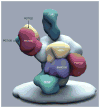Antibody responses to envelope glycoproteins in HIV-1 infection
- PMID: 25988889
- PMCID: PMC4834917
- DOI: 10.1038/ni.3158
Antibody responses to envelope glycoproteins in HIV-1 infection
Abstract
Antibody responses to the HIV-1 envelope glycoproteins can be classified into three groups. Binding but non-neutralizing responses are directed to epitopes that are expressed on isolated envelope glycoproteins but not on the native envelope trimer found on the surface of virions and responsible for mediating the entry of virus into target cells. Strain-specific responses and broadly neutralizing responses, in contrast, target epitopes that are expressed on the native trimer, as revealed by recently resolved structures. The past few years have seen the isolation of many broadly neutralizing antibodies of remarkable potency that have shown prophylactic and therapeutic activities in animal models. These antibodies are helping to guide rational vaccine design and therapeutic strategies for HIV-1.
Conflict of interest statement
The authors declare no competing financial interests.
Figures



References
Publication types
MeSH terms
Substances
Grants and funding
LinkOut - more resources
Full Text Sources
Other Literature Sources
Medical
Miscellaneous

